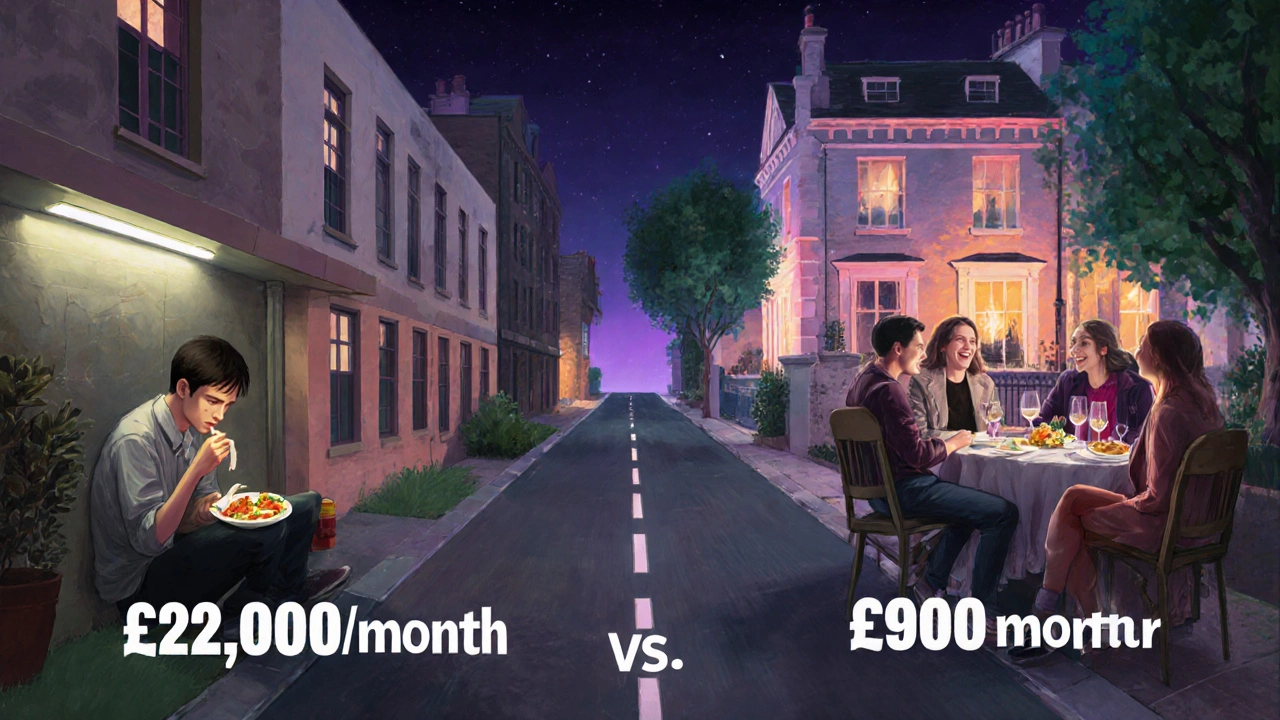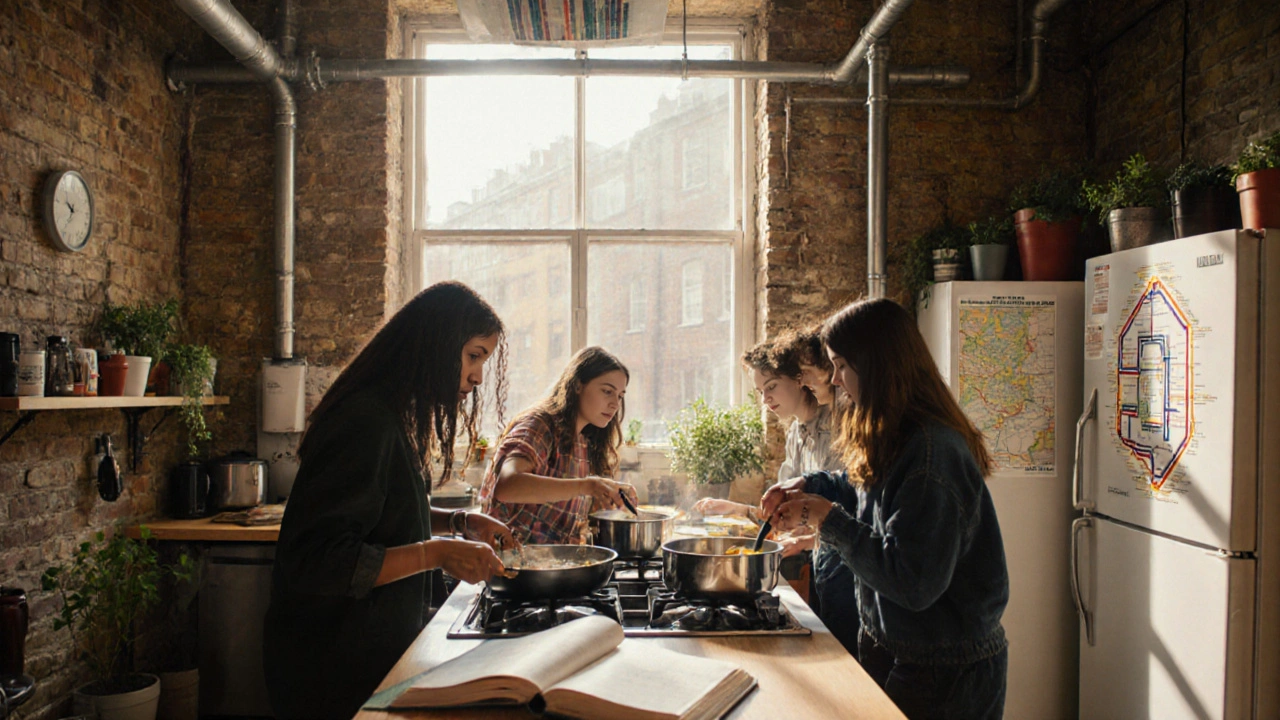Living in London as a student isn’t just about lectures and libraries-it’s about finding a place to sleep, cook, and survive without going broke. If you’re heading to UCL, KCL, LSE, or Imperial, you’re in one of the most expensive parts of the city. But that doesn’t mean you’re stuck with overpriced studios or a 90-minute commute. The right housing choice can save you hundreds a month and make your student life actually bearable.
Know Your Campus, Know Your Neighborhood
Each of these universities sits in a different part of London, and each area has its own rent prices, vibe, and commute realities. You can’t treat them the same.UCL is in Bloomsbury, right in the middle of academic London. Rent here is high because it’s central and packed with students. A studio near Gower Street can cost £1,800-£2,300 a month. But walk 15 minutes to King’s Cross or Camden, and you’ll find rooms for £1,300-£1,600 with a 20-minute tube ride to campus. Many students trade a slightly longer commute for real savings.
KCL has two main campuses: Strand (City) and Denmark Hill (South London). Strand is right next to the Thames, near Covent Garden. Rent here? £1,700-£2,200 for a studio. But if you look in Peckham, Camberwell, or even Brixton, you can find shared flats for £1,100-£1,400. The train from Brixton to Waterloo takes 12 minutes. That’s cheaper, quieter, and still fast.
LSE is tucked between the City and Westminster. It’s surrounded by luxury apartments and government buildings. A one-bedroom near Aldwych? £2,000-£2,500. But head to Elephant & Castle or New Cross, and you’ll find rooms for £1,000-£1,300. The Jubilee Line from Elephant & Castle gets you to Covent Garden in 15 minutes. Most LSE students who live here are either on scholarships or working part-time.
Imperial is split: South Kensington (main campus) and White City (new science campus). South Kensington is one of the priciest zones in London. A studio here? £2,200-£2,800. White City is cheaper and growing fast. Rent near White City is £1,400-£1,800, and the Tube ride to South Kensington is only 10 minutes. If you’re studying engineering or computing, White City is a smart pick-lower rent, modern buildings, and fewer tourists.
Shared Flats Beat Studios Every Time
Unless you’re independently wealthy, renting a studio alone in central London is a financial trap. Most students who live alone end up skipping meals, working 25+ hours a week, or dropping out.Sharing a flat with 3-5 other students cuts rent by 50-70%. In Camden, a room in a 5-bedroom flat near UCL goes for £900-£1,100. In Peckham, near KCL, you can get a room for £800-£950. These places usually include bills, Wi-Fi, and sometimes even cleaning. You’re not just saving money-you’re building a social network. Many of my friends met their flatmates in their first week and still live together after graduation.
Use student housing platforms like Uninest, Student.com, or Rightmove’s student filter. But don’t just scroll. Call the landlord. Ask if the deposit is protected (it must be by law). Ask if the flat has been inspected. If they say “no inspection,” walk away. A dodgy flat can cost you more in lost rent or health bills than it saves.
University Halls Are Not Always the Best Deal
Universities push their halls like they’re luxury resorts. But here’s the truth: they’re often more expensive than private rentals, and you’re locked in for a full year.UCL halls like Charles Morris Hall charge £1,600-£2,000/month for a single room. That’s more than a shared flat in Camden. KCL’s Maple Hall is £1,500-£1,900. LSE’s Student Village is £1,700-£2,100. Imperial’s South Kensington Halls? £2,000-£2,600.
Why do students pick them? Because they’re “convenient.” But convenience doesn’t pay your bills. Most halls don’t let you cook properly-kitchens are tiny, shared, and always dirty. You’re stuck buying takeout every night. That adds £200-£300/month.
Only pick a hall if:
- You’re an international student with no one to help you find a flat
- You’re in your first year and want to meet people fast
- You’re on a scholarship that covers hall fees
Otherwise, skip it. You’ll save £5,000-£8,000 a year. That’s a trip home, a laptop upgrade, or a semester abroad.

Timing Is Everything
The best flats get snapped up by February. By June, you’re left with the last room in a basement near a train station.Start looking in October for September moves. That’s when landlords list new rooms. If you wait until July, you’ll pay 20-30% more for worse places. I know a student who waited until August and ended up in a flat with no hot water for three weeks. She had to shower at the gym.
Use Google Maps to check commute times from potential flats to campus. Type in “walking time from [address] to [university]” and see what you’re really signing up for. A 10-minute walk is great. A 35-minute walk with no shelter from rain? Not worth it.
Hidden Costs No One Tells You About
Rent isn’t just the monthly payment. Here’s what gets added:- Deposit: Usually 5 weeks’ rent. Must be in a government-approved scheme. If they don’t say which one, don’t pay.
- Agency fees: Illegal in England since 2019. If a landlord asks for one, report them to the local council.
- Bills: Some flats include gas, electricity, water, and Wi-Fi. Others don’t. Always ask. A £1,000 room with £200 bills is a £1,200 room.
- Contents insurance: Your stuff isn’t covered by the landlord’s policy. Get a student policy from Endsleigh or AXA-it’s £20/month.
- Transport: If you’re not walking, you’ll need a Student Oyster card. It’s 30% cheaper than a regular one. Apply online through your university.
One student at LSE thought her rent included bills. It didn’t. She got a £400 electricity bill in January. She cried in the library. Don’t be her.

What to Do If You Can’t Find Anything
If you’ve looked everywhere and still have no place:- Ask your university’s housing office. They have a waiting list for last-minute rooms.
- Check Facebook groups: “UCL Student Housing 2025,” “KCL Flatmates London.” People drop out and post last-minute rooms.
- Try subletting. Some students leave early and rent out their room for half the term. You can get a 3-month deal for £500/month. Not ideal, but better than sleeping in a hostel.
- Consider moving to Zone 3. Places like Stratford, Croydon, or Walthamstow are 30-40 minutes away but cost £800-£1,000. The Tube is reliable, and you get actual space.
One friend of mine lived in Walthamstow and walked to the station every morning. He saved £6,000 a year. He bought a bike, got fit, and still made it to class on time.
Final Tip: Don’t Just Rent-Choose Your Life
Your housing decision isn’t just about money. It’s about your mental health, your study habits, your social life.Living alone in a tiny flat in Bloomsbury? You’ll be stressed, lonely, and broke.
Living in a loud, shared house in Peckham with 5 other students who cook curry every night? You’ll be tired, but you’ll have friends who help you through exams.
Choose based on what you need-not what looks nice on Instagram. The best student housing isn’t the cheapest. It’s the one that lets you focus on your degree without losing your mind.
Is it cheaper to live in student halls or private rentals near UCL, KCL, LSE, and Imperial?
Private rentals are almost always cheaper-if you share. A single room in a shared flat near UCL costs £900-£1,100, while UCL halls charge £1,600-£2,000. The same applies to KCL, LSE, and Imperial. Halls include fewer amenities than they claim, and you pay more for less space and worse kitchens.
When should I start looking for student housing in London?
Start in October for a September move. Landlords list new rooms between October and January. By June, the best options are gone, and prices rise. Waiting until July or August means paying 20-30% more for worse locations.
Can I rent a room without a UK guarantor?
Yes. Many landlords accept international students with proof of funds, a letter from the university, or a deposit insurance service like GuarantorScheme or Rent Guarantor. Some agencies specialize in helping overseas students. Avoid anyone who demands cash upfront without a contract.
Are there any areas near these universities I should avoid?
Avoid places with no Tube access and no bus routes. Some landlords list flats in zones like North Woolwich or South Oxhey as “near Imperial” or “close to KCL”-they’re 50+ minutes away. Stick to Zone 1-3. Check Transport for London’s journey planner before signing anything. Also avoid flats above noisy pubs or next to construction sites. Noise complaints are common.
How do I know if a deposit is protected?
By law, your deposit must be in a government-approved scheme: MyDeposits, Deposit Protection Service (DPS), or Tenancy Deposit Scheme (TDS). Your landlord must give you proof within 30 days. If they don’t, you can claim up to 3x the deposit back. Always ask for the certificate before you pay.
If you’re heading to one of these universities, remember: housing isn’t a luxury. It’s your foundation. Get it right, and you’ll have energy for your studies. Get it wrong, and you’ll be drained before term even starts. Don’t rush. Don’t guess. Do the math, ask the questions, and pick a place that lets you breathe.
